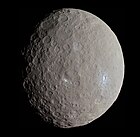Dwarf planets
|
||
Four notable dwarf planets (clockwise from top left):
(See full list of likeliest possible dwarf planets.) |
(See full list of likeliest possible dwarf planets.)
A dwarf planet is a planetary-mass object that is neither a planet nor a natural satellite. That is, it is in direct orbit of a star, and is massive enough for its gravity to crush it into a hydrostatically equilibrious shape (usually a spheroid), but has not cleared the neighborhood of other material around its orbit.
The term dwarf planet was adopted in 2006 as part of a three-way categorization of bodies orbiting the Sun, brought about by an increase in discoveries of objects farther away from the Sun than Neptune that rivaled Pluto in size, and finally precipitated by the discovery of an even more massive object, Eris. The exclusion of dwarf planets from the roster of planets by the IAU has been both praised and criticized; it was said to be the "right decision" by astronomer Mike Brown, who discovered Eris and other new dwarf planets, but has been rejected by Alan Stern, who had coined the term dwarf planet in April 1991.
The International Astronomical Union (IAU) currently recognizes five dwarf planets: Ceres; Pluto; Haumea; Makemake; and Eris. Brown criticizes this official recognition: "A reasonable person might think that this means that there are five known objects in the solar system which fit the IAU definition of dwarf planet, but this reasonable person would be nowhere close to correct."
...
Wikipedia




